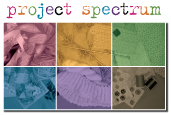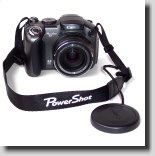
Angel Petals is a three-layered flower consisting of a felted wool center sandwiched between two layers of Angelina. To create the Angelina layers, pull some fibers from a mix of Angelina “Hot Fix” colors, and place them on a piece of parchment paper or a Teflon pressing sheet. I used Raspberry Sparkle, Cotton Candy, Sugar Plum, and Violette Crystalina. Pull enough fiber to create two flower layers. Better results are usually obtained when colors are mixed well.

Angelina “Hot Fix” Fiber Mix
Place a piece of parchment paper on top of your mixture and press at a “silk” setting for about 3-4 seconds. Let cool and then check to see if all the fibers bonded. You should have a nice piece of flat iridescent fabric.

Angelina Fabric
For the next step, make a new four-petal flower template a little smaller than the template used in step one. Place the template on the Angelina fabric and cut out two flowers. If your piece of Angelina isn’t large enough for two flowers, simply repeat the previous step for the second flower. (Remember to save your scraps for future projects.)

Cut Angelina Petal Layer
Attach the Angelina layers to the top and bottom of your flower center with a tiny dab of fabric glue placed strategically at the outer area of the flower centers. Offset their position so that the petals fall between the felted flower petals. Just a slight touch of glue will do the job since the edges of the cut Angelina will naturally want to adhere to the felted wool. Also, you will be felting the center of the flower, so keep the glue clear of this area.

Sandwiched Flower Layers
Next, cut a small circle of craft felt for the flower backing.

Craft Felt Backing
Attach it to the back of your flower using the method above. Just a touch of glue will do the job since this piece will be secured by the felted center.

For the fluffy center, cut six short strands of yarn in a contrasting color. I used a yellow boucle. Any yarn that can be pulled apart should work well.

Position two strands in the center of your flower front, forming an “X” shape. Lightly felt them in place with you needle punch machine, keeping the flower stationary and only felting the very center.

Felting Yarn Strands
Now take two more strands of yarn and wrap them with a coordinating color of Angelina. A few twists should do the job.

Angelina Wrapped Yarn Strands
Place them in an offset position on top of the previous felted strands of yarn and needle punch them in place. Use the last two strands of yarn to fill inany open areas.

Check the back of your flower to make sure the yarn has felted through to the back. Using your fingers, pull the yarn strands apart until they fluff up and fill the center. You can cut the strands to any length you desire.

Felted Through to the Back
To complete your flower, sew a brooch pin on the back, using a strong polyester thread. I like to place a little glue on the pin before sewing so that it stays in place.

You now have a beautiful little flower to give as a gift or to embellish your summer wardrobe.
~~~~~~~~~~~~~~~~~~~~~~~~~~
N. Rene West
Time Treasured
































